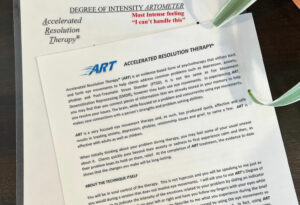
If you’ve ever heard of accelerated resolution therapy or ART, then you probably know that it is a relatively new treatment for post traumatic stress disorder (PTSD). This is a form of therapy that uses eye movements to help clients process traumatic memories. We talked about the differences between ART and EMDR on the blog a couple of months ago. Today we’ll take a closer look at what exactly Accelerated Resolution Therapy is, what happens in a session, its benefits, and even its drawbacks.
Accelerated resolution therapy was developed by Laney Rosenzweig over a decade ago and is loosely based on the principles of eye movement desensitization and reprocessing (EMDR). It can be used in conjunction with other therapies to help patients feel better and improve their quality of life.
What is Accelerated Resolution Therapy – ART?
Accelerated resolution therapy (ART) is a therapy technique that combines the principles of several traditional forms of therapy to reduce the effects of stress-inducing memories. ART is designed to detach negative emotions from the memory of traumatic events, and it has been shown to be effective in treating many conditions, including PTSD and depression.
ART is an evidence-based practice and has been recognized by Substance Abuse and Mental Health Services Administration (SAMHSA). During ART sessions, patients use rapid eye movements to reprocess memories from a traumatic event that they may find difficult or painful to discuss with their therapist.
Because ART focuses on reprogramming one image at a time, it can often be used to address the symptoms of PTSD in just a single session, dubbing it the “Rapid Relief” treatment for trauma in some circles. This approach is particularly beneficial for clients who have a limited number of trauma-related memories to process.
The ART protocol was developed by licensed marriage and family therapist Laney Rosenzweig after she found that eye movement desensitization and reprocessing (EMDR) was effective in treating PTSD but she found that it was too intense for her clients. By modifying the EMDR treatment protocol, she created accelerated resolution therapy, which has been clinically proven to be effective in the treatment of PTSD.
In ART, the therapist uses their hand to move smoothly from right to left and back again at comfortable distances, causing smooth-pursuit eye movements that the client’s brain responds to. The brain engages these movements as it reprocesses the images from the traumatic event, making connections between that memory and other thoughts or feelings that may be associated with the same event.
During an ART session, the therapist may ask the client to focus on a specific object or a particular thought or idea. As the brain processes this information, it will make new connections that can be positive and help to improve the individual’s overall well-being.
ART is a safe, non-invasive, and brief therapy that can be used by any licensed mental health therapist or medically licensed clinician who has received training in trauma intervention. ART also offers a flexible schedule that can be adapted to fit the needs of busy work and family schedules.

What happens in an ART session?
During an ART session, the client is guided by a mental health professional to perform sets of eye movements similar to what they would experience during sleep. The eye movements help the patient disengage negative emotions from traumatic memories that cause them stress and anxiety.
The therapist also asks the client to focus on their body sensations during these visualizations, which can help them slow down their stress response and relax. “Where do you feel that in your body?” “Can you describe the sensation? (is it heavy, electric, hot, restricting…?” When the person begins to feel tense, the therapist will pause the visualization and may ask the client to do another body scan. The therapist will continue this process until the client is able to calm down and remember the memory without feeling any stress.
Once the image or memory is re-established, the therapist will encourage clients to rescript or create changes to the image or memory that are positive. This change can be about the details of the memory or the feelings that accompany it. The therapist may even encourage them to try to imagine a different scenario for the event that caused them distress, which is called voluntary memory replacement.
This change can be a very powerful one, as it can eliminate the pain and anxiety that is associated with the traumatic experience. It can also lead to an increased sense of self-awareness and a better understanding of how the event affected the individual.
Although ART is a relatively new form of PTSD therapy, it has been shown to be effective in reducing the symptoms of this disorder. It is commonly used in conjunction with EMDR.
The primary difference between ART and other therapies is that ART does not involve hypnotherapy or a client’s need to recall or process traumatic memories between sessions. In addition, ART is less directive than EMDR and is usually administered in a shorter time frame.

What are the benefits of ART?
Accelerated Resolution Therapy, is an innovative treatment model for posttraumatic stress disorder (PTSD). This therapy is known to help patients find relief from distressing symptoms in just one or five sessions. In addition, ART can help people who have other mental health concerns, such as depression and anxiety.
The therapist-facilitated process of ART allows clients to process the traumatic experience in their own minds. It does not require them to verbalize what they are going through, and this can be a huge benefit for many trauma survivors.
PTSD is a condition that can be triggered by many outside stimuli and internal stimuli or sensations. ART processes physical sensations using full-body scans and visualized images. The body scans help the client regulate uncomfortable physical symptoms- thus reducing triggers.
As the individual visualizes, they will often feel uncomfortable bodily sensations, such as tightness or pain in their chest. To combat these feelings, ART therapists will pause the visualization and ask the patient to focus on their breathing until they are relaxed again. This alternating between memory processing and bodily awareness can help reduce the intensity of the memories, making them easier to process.
After the traumatic memory is processed, a therapist will give the client an opportunity to choose what they want to work on next. Some clients may choose to focus on a specific problem or image that is holding them back from finding healing.
Another benefit of ART is that it requires less effort on the part of the client than other therapies. The therapist’s hand will guide the client’s smooth-pursuit eye movements, which have been found to be relaxing and effective in helping them access their internal stimuli. ART as an effective therapy for PTSD, depression and personal resilience.
A few potential drawbacks of ART?
1) In ART, the therapist guides the client to visualize images that represent their distressing memories and replace them with more positive ones. This is similar to hypnotherapy, where the client is encouraged to relax and focus on visualizations. Clients who struggle to visualize or imagine experiences may initially feel anxious when starting the ART process.
2) ART is a manualized therapy in that therapists follow a step-by-step protocol to guide their clients through the process. The therapist may not discuss specific traumatic episodes with their clients- a departure from traditional talk therapy and something that might not meet a client’s expectations.
3) ART has not had longitudinal studies so its benefits may fade- antidotal information supports permanent improvement but this has yet to be studied.
4) While ART can be an excellent choice for treating PTSD, it is not without its drawbacks. The final drawback is that it requires a high level of commitment from the client. They must be willing to focus their attention on the traumatic memories they are working through and not on other issues.
Is Accelerated Resolution Therapy right for me?
Here at MUV Counseling in Scottsdale, our therapists are licensed and trained in Acceleratored Resolution Therapy. We’ve used this treatment and seen it work in trauma survivors many times. We believe that if you’re able to hold a thought, can move your eyes back and forth, and most importantly if you’re motivated to change for the better and heal your traumas…ART is right for you. Reach out today to schedule a free 15 minute consultation to learn more about this trauma-healing therapy.



